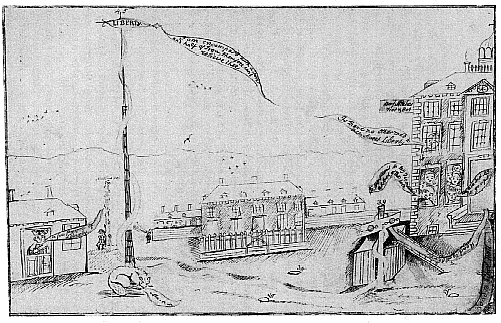 In celebration of the Stamp Act Repeal and to honor the King of England’s Birthday in 1766, New Yorker’s hoisted two poles which the festivities were held around. The symbolism of the two poles is unclear but in The Road to Mobocracy: Popular Disorder in New York City, Paul A. Gilje supposes that “the mast with the tar and pitch barrels probably represented the triumph of American maritime interests now that trade was renewed.” The second pole was fashioned in the standard for George III however “the inscriptions on the pole exposed the true sympathies of the crowd; Pitt’s name and the word “liberty” were in larger letters and displayed more prominently than the king’s name.” (p53) Following the festivities, the New Yorker’s openly refused to follow the new Quartering Act that ordered more provisions for the British soldiers occupying the city. Gilje argues that “the flagstaff, erected on ground often used for military exercise and parade, became an irksome symbol of American opposition to His Majesty’s troops stationed in the city” thus making it a historical symbol of change in New York City. (p53,54)
In celebration of the Stamp Act Repeal and to honor the King of England’s Birthday in 1766, New Yorker’s hoisted two poles which the festivities were held around. The symbolism of the two poles is unclear but in The Road to Mobocracy: Popular Disorder in New York City, Paul A. Gilje supposes that “the mast with the tar and pitch barrels probably represented the triumph of American maritime interests now that trade was renewed.” The second pole was fashioned in the standard for George III however “the inscriptions on the pole exposed the true sympathies of the crowd; Pitt’s name and the word “liberty” were in larger letters and displayed more prominently than the king’s name.” (p53) Following the festivities, the New Yorker’s openly refused to follow the new Quartering Act that ordered more provisions for the British soldiers occupying the city. Gilje argues that “the flagstaff, erected on ground often used for military exercise and parade, became an irksome symbol of American opposition to His Majesty’s troops stationed in the city” thus making it a historical symbol of change in New York City. (p53,54)
Time after time, soldiers clashed with New Yorkers around the Liberty Pole. The soldiers, sensing it’s significance to the rebellious attitude of the New Yorkers and wanting to insult them, tore down the pole three different times over the next year. Disturbed by the deliberate attacks on their symbol of liberty, the New York whigs issued pamphlets describing the effect of the presence of the British military in New York. These pamphlets helped motivate New Yorkers to be persistent in not succumbing to the British soldiers and Gilje states the Liberty Pole “became a symbol of American virtue and an emblem of the Sons of Liberty.”(p57) The points Gilje states are valid and proven by the New Yorkers banding together to protect their image of freedom and property. The Liberty Pole was an empowering symbol to fight against British injustices, which lead to persistence against the British by all the colonies in the Revolutionary War.
The historical points that you discuss are very relevant in a class about trends in American History. For one the round about way that the opinions and voices were expressed through the monumental poles demonstrate the lengths at which a group of people will go to have their voices heard. Another important factor about the presence of the flag polls is that it demonstrates the importance of relatable monuments in history. Just like the statue of liberty and other major monuments in American History, just the sight of such monuments gives everyone a unifying feeling about their independence. On a scale of 1- 10 i would give this historical fact a solid 7.